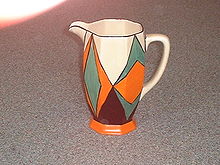This is an old revision of this page, as edited by Sannse (talk | contribs) at 17:19, 12 November 2005 (Disambiguating depression). The present address (URL) is a permanent link to this revision, which may differ significantly from the current revision.
Revision as of 17:19, 12 November 2005 by Sannse (talk | contribs) (Disambiguating depression)(diff) ← Previous revision | Latest revision (diff) | Newer revision → (diff)Clarice Cliff (January 20, 1899 - October 23, 1972), was a ceramic artist active from the late 1920s to the late 1930s.
Clarice was born in Tunstall, Stoke-on-Trent. She studied at the Burslem School of Art.
Her first job was as a gilder, and once she had mastered this she changed jobs to improve her painting decorating skills at another potbank then moved to A.J. Wilkinson's in 1916, perhaps attracted by their reputation for strong use of color in their ware.
This was an unusual start to an unusual career, most 'pottery girls' mastered a particular skill and then stayed with that to maximise their income as they were paid by the piece. However, Clarice was ambitious and prepared to take wage reductions to start at the bottom on a new skill, in the process acquiring a wide range of skills including outlining, tube lining, enamelling, banding and modelling.
Eventually Clarice's wide range of skills were recognised, and she was given an opportunity to decorate some of the factory's defective 'glost' (white) ware in her own freehand patterns. She covered the imperfections in a striking Art Deco style that was to become known as 'Original Bizarre' and has the Newport Pottery backstamp. To the surprise of the company's salesmen, this was immediately popular and she was provided with her own studio and initially another paintress to assist, rapidly expending to a team of around 70 young paintresses to hand paint the wares under her direction. Through the depths of the Depression her wares continued to sell in volume at what were high prices for the time.
After she became sucessful, she naturally spent more time with the factory owner Colley Shorter, and this gradually developed into a affair, conducted in the greatest secrecy. In 1940, after the death of Ann Shorter, Colley's wife, they married and Clarice moved into the Shorter House, Chetwynd House where she developed a strong interest in maintaining and improving the extensive gardens.
During World War Two only plain white potter was permitted so Clarice did management work but was not able to continue designing. After the war, most production went to the US market where the taste for formal ware was for traditional English designs, not the striking ware that Clarice was known for. Thus she was never able to return to creative work. A.J.Wilkinson and their Newport Pottery continued to sell work under Clarice’s name until 1964 when the factory was sold to Midwinter who also continued to use the 'Clarice Cliff' brand on some pieces.
In 1972 the first Clarice Cliff exhibition took place at Brighton, East Sussex, for which she provided comments for the catalogue. Later that year Clarice died suddenly at Chetwynd House. This exhibition marked the start of a major revival of interest in Clarice's work, which has continued to be sought after by Art Deco Ceramic collectors.

Her earliest pieces from the late 20s are traditional shapes decorated in strongly geometric patterns of diamonds and triangles in bold contrasting colours, and now called 'Original Bizarre'. This early ware is usually stamped 'Bizarre' and sells for moderate prices at auction.
By the early 1930s Clarice was designing her own shapes, often very angular and high Art Deco. Abstract and cubist patterns appeared, such as 'Sunray' and 'Ravel', and also landscapes of trees, flowers, cottages...
but these are not like anyone else's landscapes or trees...
Clarice's are highly stylised and interpreted in stong colours, such as the 'Honolulu' pattern. Typically stamped 'Bizarre' or 'Fantasque', rare combinations of shape and pattern can attract very high prices at auction.
By 1935 tastes had changed and the 'My Garden' series had become popular, with more rounded shapes, often with small flowers cast into a handle or foot and only these painted in detail.
Other series from this period include 'Harvest' which often has a corncob or raffia surface, and the 'Le Bon Dieu' in the shape of pieces of tree branch. This late 1930s ware attracts relatively low prices at auction, though becoming more valuable.
After the second world war, although Clarice had no creative input into the ware her 'Clarice Cliff' mark was frequently added to the standard ranges made by the factory. This postwar ware has little value at auction.

A chain of mergers eventually led to Wedgwood owning the brand, and in the late 1990s they produced a range of reproductions of the highly sought 1930s Deco pieces. These are made to a high quality, and were produced in small numbers for sale to collectors who could not find (or perhaps could not afford) the most striking original pieces.
These hand painted collectors pieces have already acquired significant values at auction. Other pieces were made in larger quantities with printed (not hand painted) patterns, and these are also starting to be sought at auction. These reproductions should not be confused with forgeries (of which a number are found), the Wedgwood ones are clearly marked as 'Wedgwood Clarice Cliff' and were produced by the current holder of the copyright.
1999 saw the centenary celebrations of Clarice's life and work. This featured the ‘Bizarre Art’ exhibition at the Wedgwood Visitors Centre, Barleston, Stoke-on-Trent.
See also
External links
- The Clarice Cliff Web Site Information and links.
- The Clarice Cliff Collectors Club Biographical details, exhibition information and links to images of her designs.